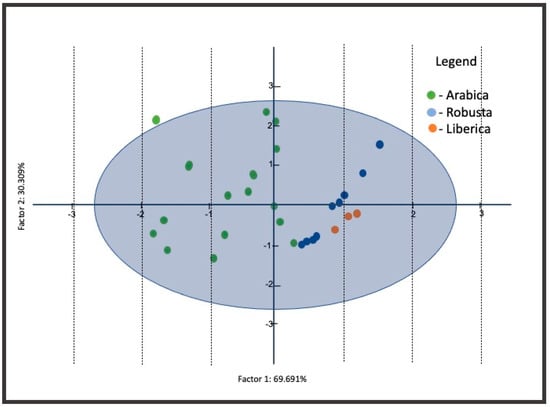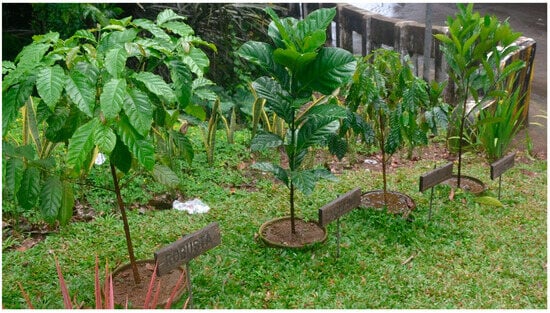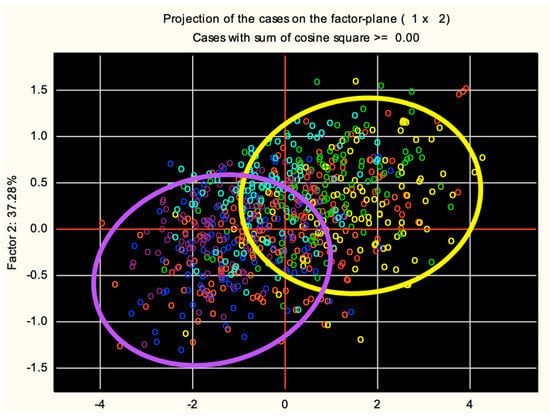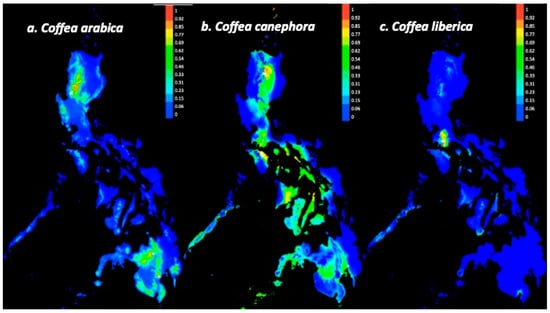Abstract
The Philippines is one of only a few countries where Coffea liberica is commercially produced. Two infra-species, C. liberica liberica (also locally known as ‘liberica’) and C. liberica var dewevrei (also known as ‘excelsa’) comprise 1.1% and 5.7% of the national coffee production, respectively. These rare varieties are produced widely in the provinces of Batangas and Cavite mainly because of historical affinity, a local market, and more recently the renewed interest from importers. Aside from its unique flavor profile, renewed interest comes from the potential of the larger beans and deeper root systems of the species to thrive on a warming planet. In this paper, we present work that has been performed in evaluating bean morphology, chlorogenic acid, caffeine content and genetic variability of C. liberica varieties from different areas of the country. The initial efforts to predict areas for increased production were based on a maximum entropy model. Combining these data provides insights into development areas for increased production in the Philippines.
1. Introduction
Coffea ‘liberica’ is often referred to as the rare and even elusive variety of commercially grown coffee. This is because only 2% of the global coffee production is C. liberica [1]. The species is grown commercially in five countries—Indonesia, Malaysia, Vietnam, Ethiopia, and the Philippines—mainly for local consumption, although some have exported to the emerging specialty coffee industry. Surprisingly, C. liberica comprises 90% of coffee cultivated in Malaysia [2].
C. liberica is locally well known to the countries that produce them; however, C. liberica remains a gem to be discovered for the rest of the world. C. liberica is referred to as a ‘heirloom species’ in the Western world, where it is sold. In Australia, it is called a ‘heritage variety’ (Adams and Russell, 2018). Two varieties of this species are traded: ‘liberica’ and ‘excelsa’. C. liberica trees are taller with larger leaves, making harvesting more difficult. The beans are much bigger than C. arabica or C. canephora resulting in less production per tree [3].
C. liberica cups may have a very complex full-bodied flavor profile, distinct from the other commercial species. Not many have experimented roasting the species given the limited availability of this variety. C. liberica is characterized as having a “fruity, woody taste similar to jackfruit, with bitter top-notes”. This is very different from the varied floral and fruity, sweet, and slightly acidic profile of C. arabica. The bitter earthy character of C. canephora and C. liberica has also found its way into the instant or soluble coffee market. C. liberica is slowly gaining attention globally and is being sought from farms in the Philippines [4].
The World Checklist of Vascular Plants recognizes three species of coffee. Coffea arabica, a species originating from the natural hybridization of C. eugenioides and C. canephora. Coffea canephora, another familiar species, and ‘robusta’, which is the widely cultivated variety; thus, the term used for commercial purposes. Two infra-species of C. liberica are noted. These are Coffea liberica var liberica and Coffea liberica var dewevrei [5]. These varieties are commercially referred to as ‘liberica’ and ‘excelsa’.
This paper discusses the C. liberica in the Philippines and the work in progress on the two commercial varieties: ‘liberica’ and ‘excelsa’. Initial results of the science the industry needs for development of these varieties are presented in the country. Although it is country specific; the hope is to contribute to the growing research to understand C. liberica from the perspective of a country that has grown the species, and has also been growing the other commercial varieties: Coffea arabica and Coffea canephora. This paper chooses to focus on the research performed in the Philippines in support of the coffee industry roadmap 2021–2025 [6] and acknowledging the distinction in C. liberica.
2. Variation and Role of Nurture vs. Nature in Philippine C. liberica
The local market in the Philippines refers to a coffee branded as ‘barako’, the colloquial name for ‘stud’ and the Spanish term for ‘wild boar’, i.e., varraco. The term is associated with characteristics of fearlessness, masculinity, and toughness which are evidently associated with C. liberica and loosely associated with coffee produced in the provinces of Cavite and Batangas, which are known as the historical coffee centers in the Philippines [7]. ‘Liberica’ was apparently the primary variety grown in these provinces prior to ‘branding’, which could be confusing for people because ‘Liberica’ may refer to any coffee grown in these traditionally ‘Liberica’ growing areas, regardless of species.
2.1. Variety vs. Environment in Caffeine, CGA and Trigonelline in Philippine C. liberica
Sensorial coffee quality is affected by the of volatile and non-volatile compounds. Accumulation of non-volatile compounds, such as caffeine, chlorogenic acid, trigonelline, and sucrose in green beans is affected by environmental factors, such as altitude, shade and moisture. It is also affected by processing and variety [8]. Compared to C. arabica, C. liberica liberica and C. liberica dewevrei have a stronger taste and a more pungent aroma. The characteristic differences in flavor among coffee varieties is hypothesized to be related to the flavor profiles among coffee varieties. Bitterness and astringency in coffee are partly due to polyphenols. Polyphenols are also recognized for their antioxidant properties which are beneficial against several oxidative stress, aging, and related diseases, such as cardiovascular disease and cancer [9]. Caffeine, chlorogenic acid, diterpenes, and trigonelline are some of the more prominent polyphenols in coffee.
Caffeine is a naturally occurring stimulant commonly sourced from coffee, tea, or cacao. Chlorogenic acid and trigonelline are important alkaloids alongside caffeine in coffee. Chlorogenic acid or CGA strongly influences the taste of coffee, such as astringent, sweet, and sour tastes. This changes with concentration. Trigonelline is also considered to be the origin of the unpleasant–complex taste found after prolonged brewing. Trigonelline breaks down to pyrroles, nicotinic acid, and pyridine to produce desirable aroma attributes, such as toasted, nutty, and roasted flavors [8].
An initial study on Philippine coffee compared variation in trigonelline in all four-coffee variety sites for the same variety, and among varieties also gained insight into the contribution of the environmental factors. This study showed that the highest trigonelline content was observed in both infra-species of C. liberica, followed by C. canephora and then by C. arabica. The same study also compared trigonelline content across different sites for the same variety of coffee (Figure 1). The results indicate that significant differences in trigonelline were observed across C. arabica cultivated in different environments [10].

Figure 1.
Principal component analysis of environment across different farms where C. arabica (green), C. liberica liberica (blue), and C. liberica dewvrei (orange) are harvested.
The same cannot be said for C. liberica liberica and C. liberica dewevrei varieties. No significant differences in trigonelline content were observed. Sy et al. [11] also found significant differences in protein, DNA, caffeine, and CGA content between C. arabica and either of C. liberica liberica and C. liberica dewevrei, while the two infra-species were not different in content of the same biologically important molecules. Interestingly, this study also presented no significant differences in trigonelline, caffeine, and CGA content among beans of the same infra-species of C. liberica liberica and C. liberica dewevrei harvested from farms from different elevations and growing environments.
2.2. Morphological Characterization of C. liberica vs. C. canephora and C. arabica
2.2.1. Leaves and Tree Morphology
Variation in the leaves and tree structure are distinct because C. liberica liberica leaves are wider at the apex. The length of the leaves of Coffea liberica of variety liberica may be twice as long as C. arabica. C. liberica dewevrei leaves, on the other hand, are smaller. Note that in farms, the variations between the infra-species of C. liberica increase in range, and a greater overlap in sizes may occur. The range of leaf sizes within a tree also differs.
Distinction between leaf morphology among the four varieties was completed. Hence, C. liberica is distinct from C. canephora and C. arabica and between the latter two species. Furthermore, there is a wider overlap in the leaf lamina morphology between the two infra-species. There are distinct differences between C. liberica infra-species in laminar size, domestic distribution, major secondary attachment, and intercoastal tertiary veins among leaves [12]. This study did not decide to change the taxonomic rank of C. liberica dewevrei without further taxonomic studies. A more detailed variation within C. liberica infra-species has to be investigated with farmers in Batangas.
In both Cavite and Batangas provinces, farmers attest to the resilience of the trees to long term exposure to the sun and erratic periods of drought. They believe that, although the leaf lamina is wider, the C. liberica infra-species have reduced the loss of moisture through transpiration because of the upward orientation of the leaves and branches, with leaves facing up more in comparison to the orientation of the leaves in C. canephora and C. arabica (Figure 2). The upward facing leaves may also reduce the leaves’ surface area exposure to sunlight as well as water loss through transpiration, as initial data seem to indicate. Root systems for C. liberica are also longer, almost twice as long as C. canephora root systems, as seedlings provide them with a deeper access to water reservoirs.

Figure 2.
From left to right—young C. canephora, C. liberica liberica, C. arabica, and C. liberica dewevrei trees presenting distinct leaf morphologies and tree branch structure.
2.2.2. Seeds Morphology within C. liberica and against C. arabica and C. canephora
Coffea liberica of variety liberica has very large fruits, and compared to Coffea arabica, the fruit color is greatly varied, ranging from light yellow to deep purple. The bean shape varies in the ratio of length to width and from oblong to teardrop shapes. Within the Philippines, more than 15 different ‘kinds’ of C. liberica liberica were found just by observing the fruit from the trees.
C. liberica dewevrei, although more available, is less variable. It ranges in color from light red and yellow to bright and deep red. Green beans are smaller than C. liberica liberica with a less elongated shape. Previous research has demonstrated that the length of the minor radial axis in the bean is the characteristic which differentiates C. liberica dewevrei, C. liberica liberica, C. arabica and C. canephora.
With the limitation of only using the green coffee bean, the morphometrics of height, length, and depth at the length of the minor radial axis were compared among beans from various farms for beans that farmers identified as C. liberica liberica. The elevation of the farms was variable. The farm trees were simultaneously planted in the farms; thus, the trees were of a very similar ‘kind’.
The data indicates a wide overlap and a high variability of measurements (Figure 3). Although highly overlapping, the data from the two farms marked as purple and yellow hints at a higher similarity within farms. Farmers are observed to have farms that focus on a specific ‘kind’ of tree, as the elevation was the same for both locations. The only difference was that the dominant ‘kind’ of tree was planted, rather than focusing on the environment in which it was grown. This highlights the relative importance of the nature of the coffee plant as well as its nature.

Figure 3.
PCA on coffee bean morphometrics of C. liberica grown in six different farms in the Philippines. The purple and yellow circles are drawn around the most different clusters. These two ‘varieties’ are more different from each other than from others.
2.2.3. Genetic Characterization
Genetic characterization has received greater attention from other researchers. There is a very clear differentiation of the three species of C. arabica, C. canephora, and C. liberica through sequences from the matK of the rbcL gene or through simple sequence repeats [13]. Differentiation of C. liberica dewevrei and C. liberica liberica has been less straight forward using standard barcoding genes (i.e., matK, rbcL and trnl-psba); however, natural reproductive barriers exist between these infra-species, as evidenced by weak pollen viability of F1 hybrids [14]. Our current work involves genetic identification of mother trees and seedlings for the development of nurseries. In addition, work is on-going on the RNASeq and QTL mapping of disease resistance genes from C. liberica (e.g., SH3) and the caffeine-related gene HCT in C. liberica, as the aim is to develop C. liberica disease-resistant varieties of coffee with the desired CGA and caffeine content.
3. Defining Areas for Cultivation of Coffea liberica
Different climatic factors and environmental requirements greatly vary among Coffea species. Some of these factors include the lowland and highland locations, the different elevation of coffee plantation, optimum annual rainfall range, optimum mean annual temperature range, air humidity, and wind stress. In addition, the effects of shade have also been proven to have great interaction with the biochemical composition of coffee, most especially with green coffee beans. These contribute to changes in the different properties of coffee. Thus, environment can be classified as a contributing factor. Data on the environment can also be used to predict suitable areas for developing C. liberica plantations.
A species distribution model (SDM) was developed using the maximum entropy model (Maxent) with the presence of data only [15]. They predict possible suitable areas for each of the three species of coffee based on the data from existing locations. The models were based on nineteen bioclimatic variables as well as altitude data on the current condition, covering data from 1950 to 2000 from the WorldClim database (http://www.worldclim.org/current). The downloaded files have a spatial resolution of 30 arc seconds (1 km grid). As a preliminary output, the MaxEnt performance was good for the calculated AUC and the jackknife test. The initial models for the three varieties are presented below (Figure 4).

Figure 4.
MaxEnt model outputs for (a) C. arabica; (b) C. canephora; and (c) C. liberica. The limited distribution in C. liberica is shown.
The Maxent model for C. coffea in the Philippines generally reflects the current areas of cultivation of C. arabica and C. canephora indicating the robustness of the mode. For C. liberica, since cultivation data is only from a small area, the suitable areas for cultivation is limited [16], The maps may be further expanded with data on areas where the species have established culture.
4. Conclusions
This paper presents some new insights on the diversity of C. liberica and how it compares to C. arabica and C. canephora. It also presents the differences among the infra-species C. liberica liberica and C. liberica dewevrei. The aim is to add to the limited literature on the species from the data acquired in the Philippines. This study highlights its potential for cultivation amidst a changing climate.
Both C. liberica infra-species were found to be different from C. canephora and C. arabica in leaf and bean morphology, branching architecture, and the rooting pattern. These species have bigger front facing leaves, deeper roots, and larger beans for water storage and are more adapted to greater variation in climatic conditions, temperature stress, and drought.
Initial data also indicates that for infra-species of C. liberica the nature, or the genetic variety of the plant, the environment has a lesser influence on the phenotype in the species, particularly in the polyphenols, e.g., trigonelline, chlorogenic acid (CGA), and caffeine.
Finally, the approach of predicting areas suitable for planting varieties of coffee can was performed using a species distribution model based on maximum entropy. Parameters from WorldClim from 1950 to 2000 produced reasonable maps for C. arabica and C. canephora when the current data on where they are placed in the Philippines were given. The results for C. liberica showed a limited area given that the current areas where they are grown. When validated, these models may be very useful for future work on Philippine coffee.
Funding
This research was funded by the United States Agency for International Development (USAID), through RTI International, under USAID STRIDE grant agreement No. 0213997-G-2015-002-00, and internal support by De La Salle University using the Practical Genomics Laboratory.
Institutional Review Board Statement
Not applicable.
Informed Consent Statement
Not applicable.
Data Availability Statement
Data used in this paper are from the original research and thesis found at https://animorepository.dlsu.edu.ph/.
Acknowledgments
The researcher would like to acknowledge the contributions of Aldrin Mallari and Victor Fuentebella for the work on the species distribution model. The contributions of Janlyn Santos, Jewel Macato, Joshua Kyle Sy, and Aize Villegas are also acknowledged.
Conflicts of Interest
The author declares no conflict of interest. The funders had no role in the design of the study; in the collection; analyses; or interpretation of data; in the writing of the manuscript; or in the decision to publish the results.
References
- Gibson, M.; Newsham, P. Tean and Coffee. In Food Science and Culinary Arts; Gibson, M., Newsham, P., Eds.; Elsevier Academic Press: Amsterdam, The Netherlands, 2018; pp. 353–372. [Google Scholar] [CrossRef]
- Wahab, M.A.M.A.; Mohamad, N.A.A. Exploring the Potentials of the Coffee Industry in Malaysia. FFTC Agricultural Policy Platform. 2018. Available online: https://ap.fftc.org.tw/article/1005 (accessed on 18 July 2023).
- Types of Coffee Beans and their Characteristics. Adams and Russell Coffee Roasters. Available online: https://www.adamsandrussell.co.uk/types-of-coffee-beans-characteristics/ (accessed on 20 July 2023).
- The Beginner’s Guide to the Main Types of Coffee. Philippine Coffee Board Inc. Available online: https://philcoffeeboard.com/the-beginners-guide-to-the-main-types-of-coffee/ (accessed on 27 July 2023).
- POWO. Plants of the World Online. Facilitated by the Royal Botanic Gardens, Kew. Available online: http://www.plantsoftheworldonline.org/ (accessed on 18 July 2023).
- Department of Agriculture. Philippine Coffee Industry Roadmap (2021–2025). 2021; 150p. Available online: https://www.pcaf.da.gov.ph/wp-content/uploads/2022/06/Philippine-Coffee-Industry-Roadmap-2021-2025.pdf (accessed on 4 July 2023).
- Cao, E.P.; Constantino-Santos, D.M.; Ramos, L.A.P.; Santos, B.S.; Quilang, J.P.; Mojica, R.M. Molecular and morphological differentiation among Coffea (Rubiaceae) varieties grown in the farms of Cavite Province, Philippines. Philipp. Sci. Lett. 2014, 7, 387–397. Available online: https://scienggj.org/2014/PSL%202014-vol07-no02-p387-397%20Cao.pdf (accessed on 30 June 2023).
- Cheng, B.; Furtado, A.; Smyth, H.E.; Henry, R.J. Influence of genotype and environment on coffee quality. Trends Food Sci. Technol. 2016, 57, 20–30. [Google Scholar] [CrossRef]
- Bandyopadhyay, P.; Ghosh, A.K.; Ghosh, C. Recent developments on polyphenol-protein interactions: Effects on tea and coffee taste, antioxidant properties and the digestive system. Food Funct. 2012, 3, 592–605. [Google Scholar] [CrossRef]
- Santos, J.M.; Macato, J.; Ablan Lagman, M.C.A. Comparison of Trigonelline Content in Three Philippine Coffee Varieties. In Proceedings of the De La Salle University Research Congress; De La Salle University: Manila, Philippines, 2018; Available online: https://www.dlsu.edu.ph/wp-content/uploads/pdf/conferences/research-congress-proceedings/2018/fnh-06.pdf (accessed on 2 August 2023).
- Sy, J.K.; Villegas, A.M.L.; Ytienza, S.I.E.; Ablan Lagman, M.C.A. Comparison of total protein, caffeine, chlorogenic acid and bean morphology in infra-species of Coffea liberica. Philipp. Sci. Lett. 2023. Submitted. [Google Scholar]
- Baltazar, A.M.P.; Buot, I.E., Jr. Short Communication: Leaf architectural analysis of taxonomic confusing coffee species: Coffea liberica and Coffea liberica var dewevrei. Biodiversits 2019, 20, 1560–1567. [Google Scholar] [CrossRef]
- Panaligan, A.C.; Baltazar, M.D.; Alejandro, G.J.D. Molecular authentication of commercially cultivated coffee (Coffea spp.) in the Philippines using DNA barcodes. Int. J. Agric. Biol. 2021, 25, 227–230. [Google Scholar] [CrossRef]
- N’Diaye, A.; Poncet, V.; Louarn, J.; Hamon, S.; Noirot, M. Genetic differentiation between Coffea liberica var liberica and C. liberica var dewevrei and comparison with C. canephora. Plant Syst. Evol. 2005, 253, 95–104. [Google Scholar] [CrossRef]
- Phillips, S.J.; Anderson, R.P.; Schapire, R.E. Maximum entropy modeling of species geographic distributions. Ecol. Model. 2006, 190, 231–259. [Google Scholar] [CrossRef]
- Ablan Lagman, M.C.A. Final Report: Establishing a Repository of Philippine Coffee Varieties and SNPs markers for Variety Identification. USAID RTI Project USAID STRIDE Grant Agreement No. 0213997-G-2015-002-00.
Disclaimer/Publisher’s Note: The statements, opinions and data contained in all publications are solely those of the individual author(s) and contributor(s) and not of MDPI and/or the editor(s). MDPI and/or the editor(s) disclaim responsibility for any injury to people or property resulting from any ideas, methods, instructions or products referred to in the content. |
© 2023 by the author. Licensee MDPI, Basel, Switzerland. This article is an open access article distributed under the terms and conditions of the Creative Commons Attribution (CC BY) license (https://creativecommons.org/licenses/by/4.0/).